Sage ‘The Savior’
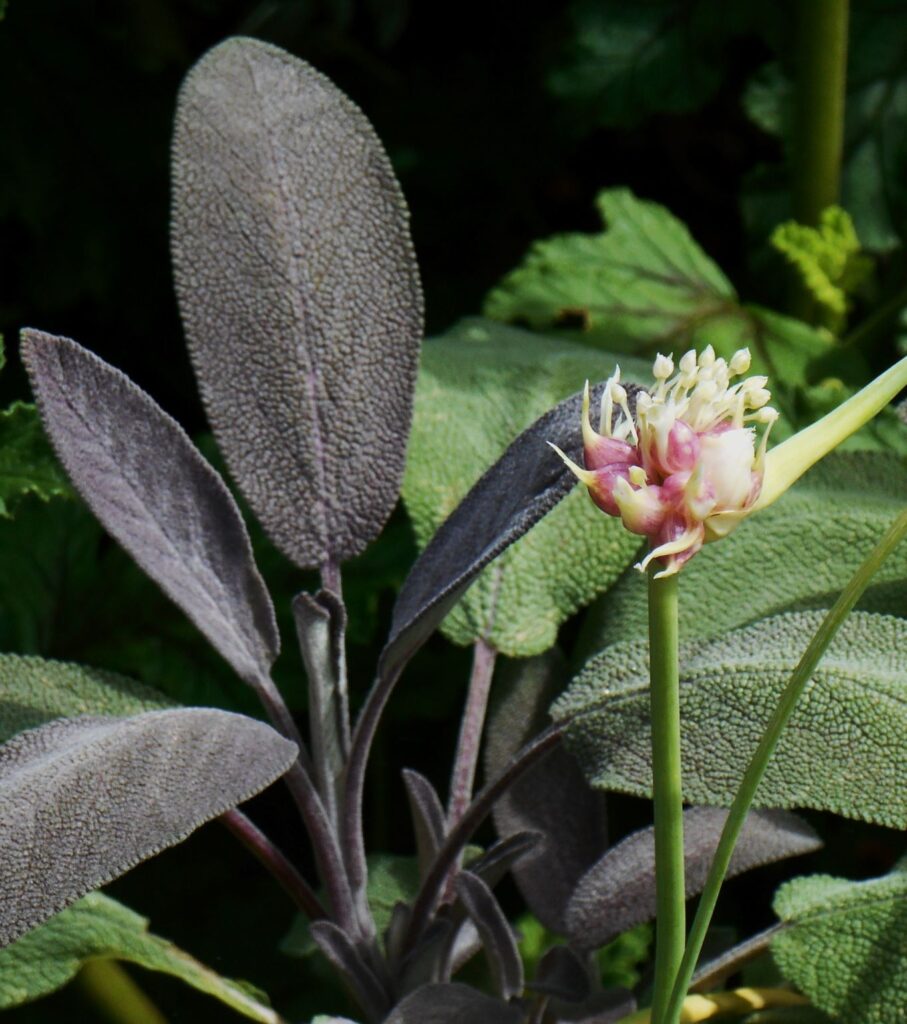
Salvia officinalis ‘Purpurea’
“Why should a man die in whose garden grows sage?
Against the power of death there is not medicine in our gardens
But Sage calms the nerves, takes away hand
Tremors, and helps cure fever.
Sage, castoreum, lavender, primrose,
Nasturtium, and athanasia cure paralytic parts of the body.
O sage the savior, of nature the conciliator!”From the Regimen Sanitatis Salernitanum ca 1100-1200 CE
The name Salvia officinalis, designating our common culinary sage, derives its species name from the Latin officina, the room in medieval European monasteries where herbs and other medicines were stored. Culinary sage, native to the northern shore of the Mediterranean Sea, has gone by many names over the centuries, including Salvia salvatrix, meaning ‘Sage the Savior,’ for its many healing properties. This designation pre-dates Christianity in this region, and in this context salvatrix is used to mean ‘to feel healthy, to heal.’ While the common name ‘sage’ denotes wisdom in modern English, Saliva is derived from the Latin salvus, meaning ‘safe, secure, and healthy.’
Natural History
Pliny the elder (23-79 CE) is the first writer in modern times known to have written about Salvia in his Naturalis Historia. Yet sage was already an important plant in the ancient world long before his time. The Romans burned dried sage during their religious rituals and considered this herb sacred to their God Jupiter, the head of their pantheon of gods and goddesses. Ancient Greeks burned sage during their prayers to Zeus, this same being known by another name. Ancient people of the Mediterranean world, from before recorded history, also used common sage in their foods, brewed it in tea, added it to cheese and beer, and took it as medicine to address a variety of health concerns.
The genus Salvia, part of the Lamiaceae, or mint family of plants, includes between 900 and 1000 species. Botanists have identified around 250 Salvia species throughout Europe, the Middle East, and Central Asia. Around 90 Salvia species have been identified in Eastern Asia, and an additional 600 species of Salvia are native to North and South America. Not all of these species are used medicinally or as edible herbs, but all have tubular, two lipped flowers that support bees, hummingbirds, butterflies, and other insects. Many have fragrant foliage containing useful essential oils.
Salvia officinalis is the main species used in cooking and medicine, and so has been spread around the world by various migrating people who valued it, in those areas where it will grow. It grows well beyond its native range in modern times. European colonists brought it with them to Virginia, and it was cultivated in the earliest settlements, and later was grown in the gardens of Colonial Williamsburg.

Salvia ‘Berggarten’ has large, grey green or silvery leaves and rarely blooms. It is grown mostly to harvest its leaves for use in cooking. Here it grows among other herbs in a raised bed tended by the ARC of Williamsburg and Master Gardeners at the Williamsburg Botanical Garden and Freedom Park Arboretum.
There are several varieties of S. officinalis commonly available to us today, which include:
- ‘Tricolor’ sage, which has mottled green, white and purple leaves, purple sage
- ‘Aurea’ sage, which has yellow or golden leaves
- ‘Berggarten’, a cultivar with large, silvery or greyish leaves which rarely blooms
- ‘Icterina’, which has yellow-green variegated leaves
- ‘Purpurascens’ (‘Purpurea’) which has uniformly dark purple leaves
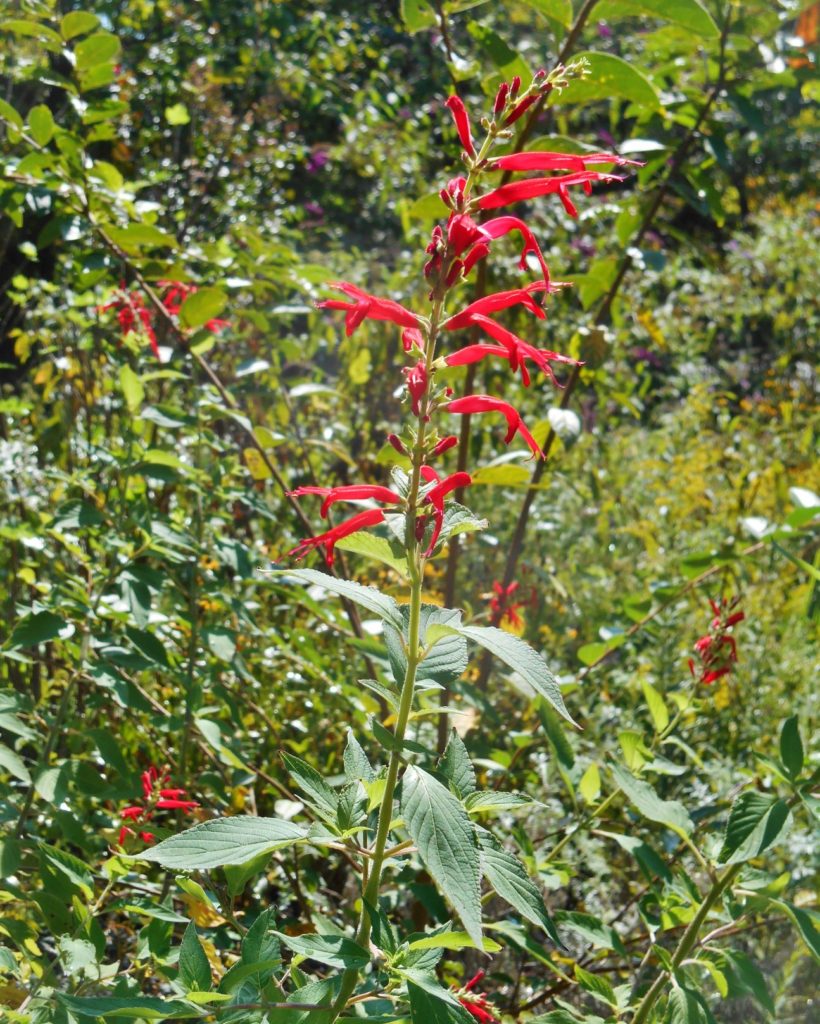
Pineapple sage, Salvia elegans, provides sweetly flavored leaves. Late hummingbirds appreciate its flowers, which open in September and October.
Other Types of Edible Salvia
In addition, pineapple sage, S. elegans, is grown for its beautiful red flowers and pineapple scented leaves. Flowers, stems, and leaves are edible. Pineapple sage is hardy in our area though it blooms very late in the season. It attracts hummingbirds, bees, and butterflies to its long spikes of orange red tubular flowers.
Clary sage, S. sclarea, another edible sage native to Europe, is a biennial plant that blooms with large spikes of flowers from June to August which support pollinators. Its seeds were used medicinally to treat inflammation around the eye. This plant is drought tolerant and dislikes wet, overly fertile soil.
Native Americans in California and other regions of the North American West use S. apiana, sacred sage or white California sage, as a sacred plant in their ceremonies. Sacred sage is an evergreen shrub which grows wild in that region. It is harvested, dried, and burned as a smudge or incense. Indigenous people also harvest the seeds to grind and mix with cornmeal or flower for several traditional foods, and use the seeds, stems and leaves medicinally. Tea can be made from this sage’s roots to help women healing after giving birth.
Medicinal Sage Tea
Tea is also made from the dried or fresh leaves of pineapple sage and common, or culinary sage. Pineapple sage tea is prepared in Mexico to treat anxiety and depression.
Tea made from S. officinalis has been used to lend clarity to thinking, to improve memory and mood, and to calm nervousness and overexcitement. Sage tea may also be used to settle the stomach, cleanse the mouth, treat sore throat, cool and treat fevers, and to purify the blood. It is used to support women’s health. The Chinese imported S. officinalis leaves from Europe to brew into tea, sometimes preferring sage tea to their own native teas because of the healing qualities of sage.
Common culinary sage may be steeped with hot malt vinegar, and then cut with an equal amount of cool water to make a gargle to treat bleeding gums or sore throats. Healers and priests used a preparation of sage brewed in vinegar to treat plague in the ancient world. Sage tea can also be brewed with boiling water, lemon or lime and sugar or honey. Most descriptions of sage tea advise limiting consumption to no more than three cups per day, as the essential oils in common sage may cause serious problems in high doses.
Honey infused with sage leaves has been used for many centuries to soothe sore throats and treat cold symptoms. Both honey and sage oils have antibacterial properties and contribute to healing.
Sage leaves have been rubbed on the teeth to clean them, and powdered dried sage has been a traditional ingredient in some tooth powders. Strong sage tea may be used, without lemon and sugar, as a hair rinse to darken the hair and as a treatment for minor cuts or abrasions. The whole leaves used for making tea may be applied topically to wounds. Sage has antiseptic and antimicrobial properties, which makes it a valuable herb in cooking and in preserving meat and other foods. Herb lore suggests harvesting sage leaves for medicinal use in early summer, before the plant blooms.
Cooking with Sage
Sage leaves may be eaten fresh, dried, or cooked. They are rich in several vitamins, minerals, and antioxidants. Fresh sage leaves can be eaten on bread with butter or may be added to salads or other vegetable dishes. Dried sage is a common ingredient in ‘poultry’ spice blends and is a distinctive flavor in sausage, holiday dressing, and roasted turkey or chicken. Fresh sage leaves may be fried in olive oil as a crispy snack or garnish. Stems of fresh sage can be added to soups, stews, or roasts as they cook, or they can be chopped finely and added to rice, barley, or quinoa as they boil. Season scrambled eggs with chopped fresh or dried sage. Add sage leaves to pickle recipes. Sage is often paired with onions in various savory dishes, gravies, and other sauces. Add fresh sage sprigs to olive oil or any type of vinegar to lend its flavor and essential oils.
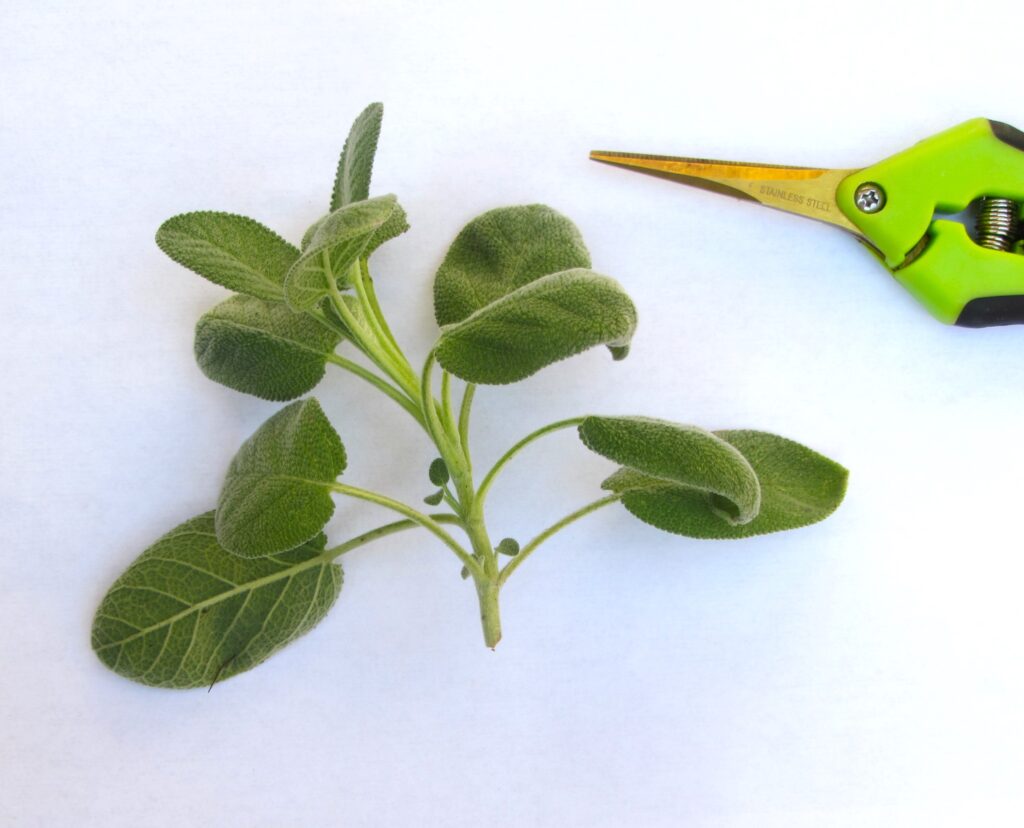
A S. officinalis ‘Berggarten’ cutting is ready to prepare for propagation and to use its lower leaves in the kitchen.
Ceremonial Uses of Sage for Purification and Protection
Sage is used to clear, clean, purify, and to pray when it is burned during religious or ceremonial rituals. Romans and Greeks believed that sage smoke carried their prayers to their gods and goddesses. Indigenous people in North American and elsewhere used sage prayerfully as well. Many indigenous American and European based spiritual practices still use smoldering bundles of dried sage to purify homes, offices, businesses, and other spaces through the practice of ‘smudging.’ Individuals recovering from illnesses, broken relationships, or depression may also be ‘smudged’ with smoke form a sage bundle to ease their burden.
Make a sage bundle by harvesting and then drying a dozen or more stems of sage. Cut the thoroughly dried sage stems, with their leaves still attached, to uniform lengths of about 4”. Tie bundles of stems together with a plant-based twine or with pliable vines or grasses to make a tight, secure bundle an inch or two in diameter.
Use a bundle of sage in a fire-proof bowl. Light one end of the bundle, allow it to flame for a few moments, and then blow out the flame. Allow the bundled sage to continue smoldering so it produces a steady stream of smoke. This smoking sage is carried and waved around the area to be smudged. When finished, make sure that any remaining sage is fully extinguished. Discard the remains of a smudge stick by burying it or composting it, but don’t throw it in the trash.
Sage is associated with the elements of earth and air, with the planets Jupiter and Mercury. Powdered dried sage may be mixed with other herbs and incense, or mixed with hot wax when pouring homemade candles.
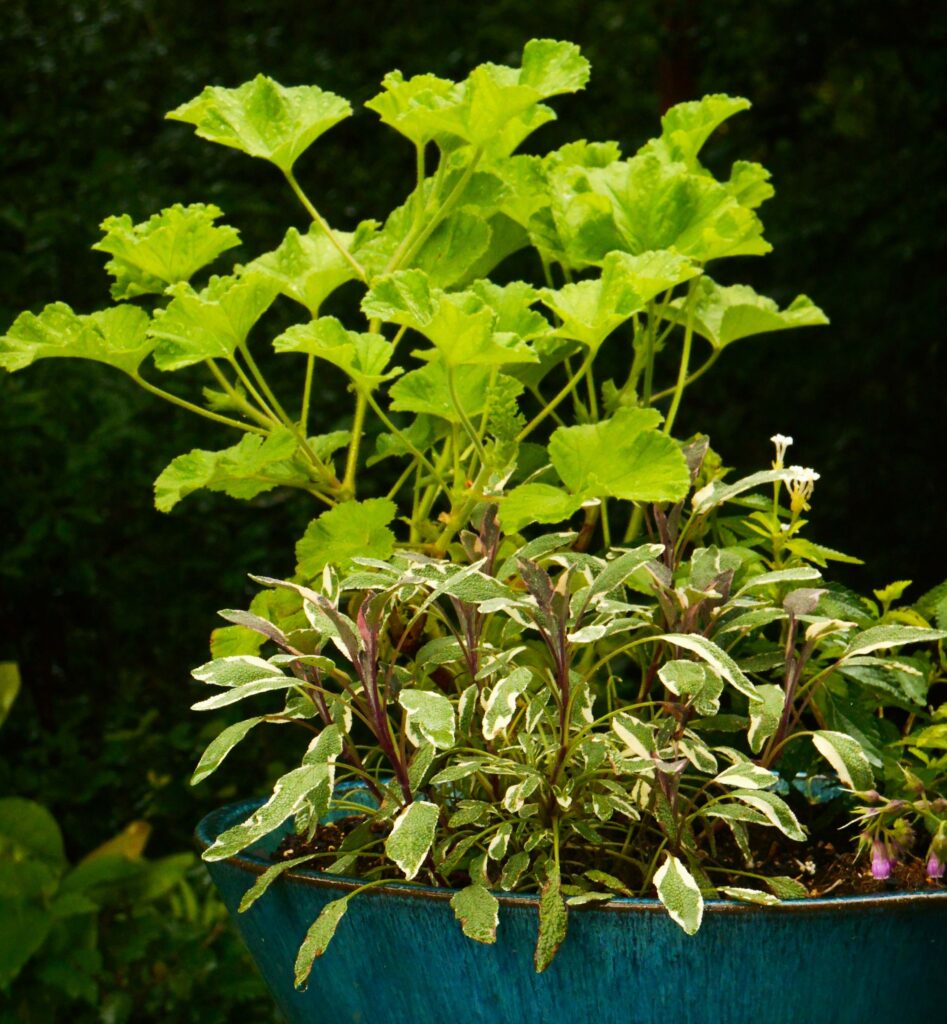
Tricolor sage grows with a scented geranium and a white Lantana in this container designed to be drought tolerant in full sun. June 2018.
Sage as an Ornamental Plant
Use fresh or dried stems of sage in wreaths, garlands, flower arrangements, or simply hang a bundle of tied stems in the kitchen or near the outer doors of your home. Ancient people believed that both fresh and dried sage cheered and protected their homes. They grew sage in their kitchen gardens and near their doors. All types of Salvias perform well mixed with other plants in beds, borders, and containers. Traditionally, sage is always planted in groupings with other plants in a container. Try combining it with golden oregano, any type of basil, or scented geraniums for a long-lasting container garden.
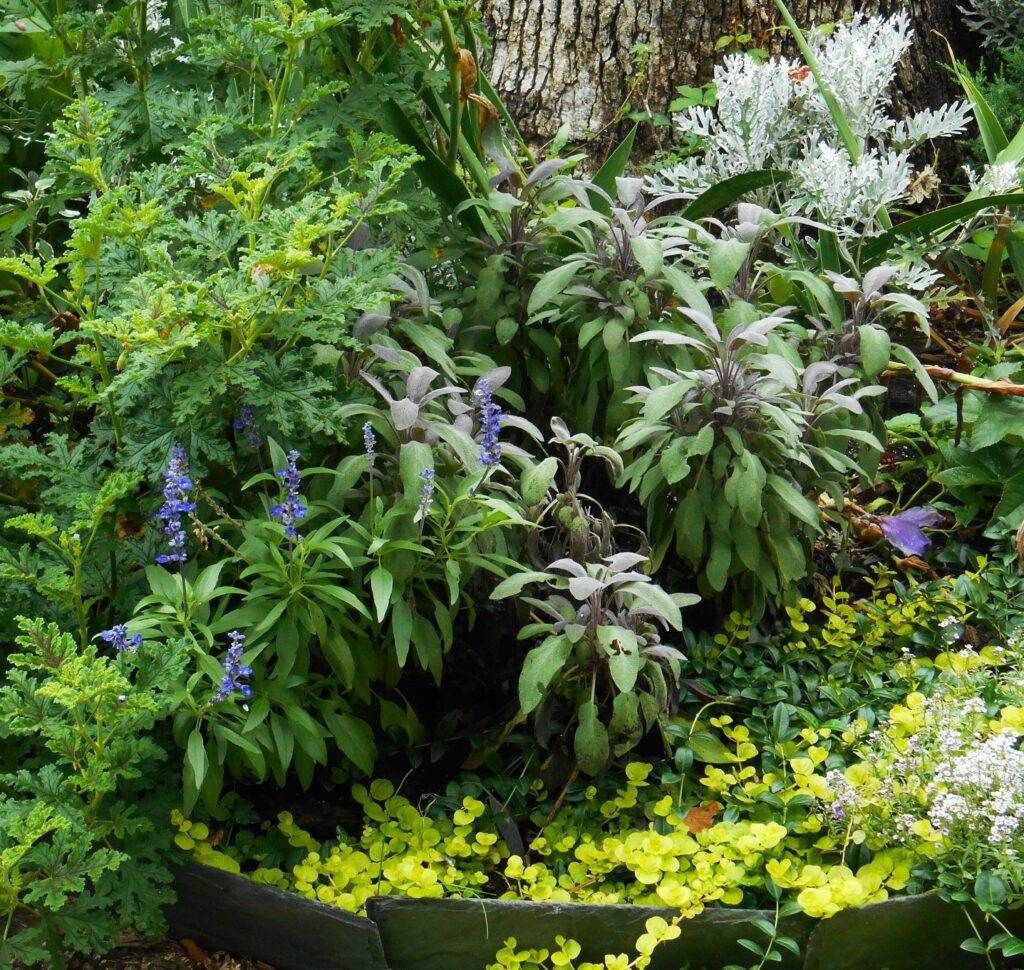
Plant sage in raised beds or garden borders among other perennials and herbs. Here, S. officinalis ‘Purpurea’ grows with scented geranium, ornamental Salvia, and groundcover vines.
Cultivating Sage
Although many types of sage grew wild on the coasts and islands of the Mediterranean, ancient people began to cultivate those they found most useful around their homes and temples. Most home, temple, and medicinal gardens included sage, along with rosemary, now Salvia rosmarinus, and thyme. Later monastery gardens included plots of sage. Europeans emigrating to North America brought sage plants with them, and so common sage spread to this continent by at least the early 17th century. Home gardeners need to give their sage plants a sunny spot with excellent drainage and good air circulation because most culinary sage is adapted to growing on dry, rocky, poor soil, in a warm climate. It won’t grow well in frequently saturated soil.
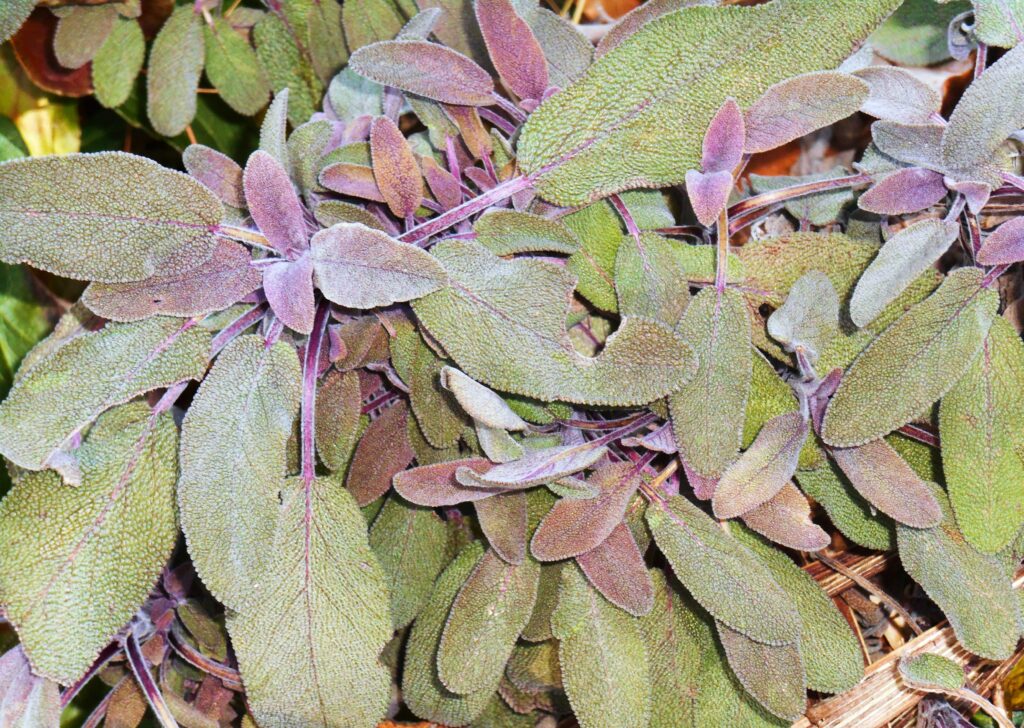
Culinary sage is an evergreen shrub which holds its leaves through winter, although growth slows down in cold weather. This photo was taken in late January of 2016.
Sage will grow as a mounding, evergreen, semi-woody small shrub in full to partial sun in Zones 4-9. It grows well on slopes, in raised beds, in containers, and in garden beds that have good drainage. Root rot from saturated soils can kill sage in areas that get frequent rain. Sage may also develop powdery mildew or verticillium wilt during humid, rainy weather.
In areas with heavy clay soils, like ours, consider growing sage in a prepared raised bed or a larger container at least 12” deep. Mulch sage with pea gravel or perma-till to prevent soil from splashing up on its leaves and to reflect light and heat up into the plant. It helps to mix pea gravel, sand, or perma-till into prepared potting soils before planting sage. Don’t over fertilize sage, as it prefers to grow a little ‘lean.’
Propagating Sage
Sage is slow to grow from seed, although seed is available for many varieties. Most commercial growers use stem cuttings. Harvest cuttings 4”-5” long in early summer before the plant blooms. Remove its lower leaves, leaving only the growing tip and 1 or 2 pair of leaves at the top of the sprigs, and stick them in moist sand, vermiculite, or potting soil. Keep the soil moist as the cuttings root in a shady spot with good air circulation. Use long, older stems to start new plants by ‘pegging’ the old stem directly onto the soil using a U shaped floral ‘greening’ pin, or by using a small rock to hold the stem in place while it roots. Scrape off a little of the stem where it touches the soil to speed rooting.
Most growers prune sage hard in mid to late spring to rejuvenate the plant and stimulate new growth. Sage is considered a short-lived perennial, often lasting for only a few years. Rejuvenate the plant by cutting it back to 6” or less in spring to prolong its life. This practice also yields cuttings to start new plants. Traditional gardeners simply stuck the cuttings into their garden beds where they wanted new plants to grow. Newly planted sage, whether from plugs or cuttings, needs to be kept watered the first year as roots develop. Don’t allow the roots to completely dry out while they establish.
Sage for Specialty Gardens
The many colorful varieties of culinary sage tempt gardeners to plant it as an ornamental plant in sustainable, drought tolerant plantings. Most culinary sage plants will grow to 1’-2’ high and 2’-3’ wide at maturity. Their leaves have a beautiful pebble-like texture, may be crinkled, and are highly fragrant. This is an excellent plant to use in therapeutic gardens designed for older adults, for those with disabilities, for children, or for any sort of healing, sensory garden. Deer and rabbits avoid grazing sage because of the essential, fragrant oils in its leaves.
Culinary sage remains a ‘savior’ for modern gardeners. We may not depend on it for healing, but it remains a tough, drought tolerant plant we can add to our garden with confidence that it will survive our weather and our wildlife. It supports pollinators when it blooms and thrives when we harvest its sprigs and leaves. Most of all, it is both beautiful and fragrant. It offers us a moment of peace and reflection when we pause to appreciate it in the midst of our busy lives.
All photos by E. L. McCoy
For More Information:
Dutton, Joan Parry. Plants of Colonial Williamsburg – How to Identify 200 of Colonial America’s Flowers, Herbs and Trees. The Colonial Williamsburg Foundation. 1979.
Grieve, Mrs. M. A Modern Herbal in Two Volumes, Volume II I-Z. Harcourt, Brace, & Company. 1931.
Keville, Kathi, and Jeffrey Laign. Complete Book of Herbs, Using Herbs to Enrich Your Garden Home, and Health. Publications International, Ltd. 1997.
Halpin, Anne M. editor. Rodale’s Home Gardening Library Herbs. Rodale Press. 1988.
Hopkinson, Patricia, Diane Miske, Jerry Parsons, Holly Shimizu, and Kathy Sammis. Herb Gardening. Pantheon Books, Knopf Publishing Group. 1994.
Ogden, Shepherd and Ellen Ogden. The Cook’s Garden, Growing and Using the Best-Tasting Vegetable Varieties. Rodale Press. 1989.
Rago, Linda Ours. Dooryard Herbs. Carabelle Books. 1984.





